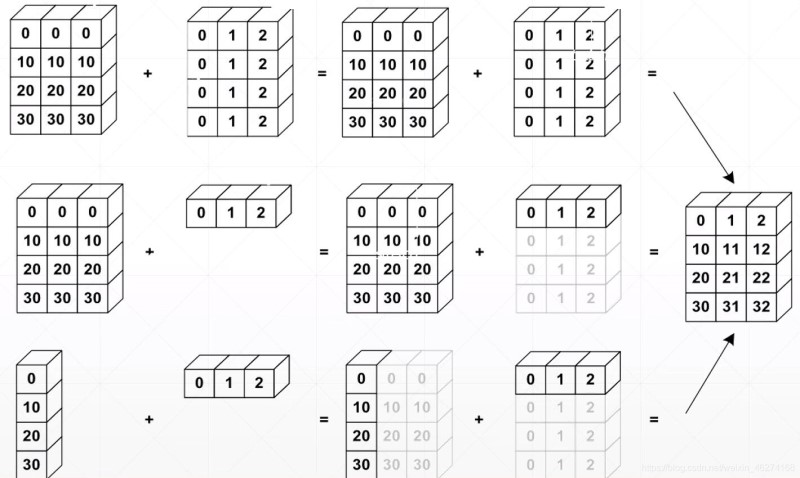索引操作

简单索引
索引 (index) 可以帮助我们快速的找到张量中的特定信息.
例子:
a = tf.reshape(tf.range(12), [2, 2, 3]) print(a) print(a[0]) print(a[0][0])
输出结果:
tf.Tensor(
[[[ 0 1 2]
[ 3 4 5]][[ 6 7 8]
[ 9 10 11]]], shape=(2, 2, 3), dtype=int32)
tf.Tensor(
[[0 1 2]
[3 4 5]], shape=(2, 3), dtype=int32)
tf.Tensor([0 1 2], shape=(3,), dtype=int32)
Numpy 式索引
我们也可以按照 numpy 的写法来操作索引.
例子:
a = tf.reshape(tf.range(12), [2, 2, 3]) print(a) print(a[0]) print(a[0, 0])
输出结果:
tf.Tensor(
[[[ 0 1 2]
[ 3 4 5]][[ 6 7 8]
[ 9 10 11]]], shape=(2, 2, 3), dtype=int32)
tf.Tensor(
[[0 1 2]
[3 4 5]], shape=(2, 3), dtype=int32)
tf.Tensor([0 1 2], shape=(3,), dtype=int32)
使用 : 进行索引
例子:
c = tf.ones([4, 14, 14, 4]) print(c[0, :, :, :].shape) print(c[0, 1, :, :].shape)
输出结果:
(14, 14, 4)
(14, 4)
tf.gather
我们假设一个有 3 个餐馆, 每个餐馆有 8 种菜系, 128 道菜data: [resturants, cuisines, dishes].

例子:
data = tf.zeros([3, 8, 128]) g1 = tf.gather(data, axis=0, indices=[0, 2]) print(g1.shape) g2 = tf.gather(data, axis=1, indices=[0, 1, 2, 3]) print(g2.shape)
输出结果:
(2, 8, 128)
(3, 4, 128)
tf.gather_nd
例子:
g1 = tf.gather_nd(data, [0]) print(g1.shape) g2 = tf.gather_nd(data, [0, 1]) print(g2.shape) g3 = tf.gather_nd(data, [0, 1, 2]) print(g3.shape)
输出结果:
(8, 128)
(128,)
()
tf.boolean_mask
格式:
tf.boolean_mask( tensor, mask, axis=None, name='boolean_mask' )
例子:
data = tf.zeros([3, 8, 128]) b1 = tf.boolean_mask(data, mask=[True, True, False]) print(b1.shape) b2 = tf.boolean_mask(data, mask=[True, False, True, False, True, False, True, False], axis=1) print(b2.shape)
输出结果:
(2, 8, 128)
(3, 4, 128)
切片操作
借助切片技术, 我们可以灵活的处理张量对象.

简单切片
格式:
tensor[start : end]
其中 start 为开始索引, end 为结束索引 (不包括)
例子:
tf.Tensor([0 1 2], shape=(3,), dtype=int32) tf.Tensor([9], shape=(1,), dtype=int32) tf.Tensor([0 1 2 3 4 5 6 7 8], shape=(9,), dtype=int32)
step 切片
格式:
tensor[start : end: step]
例子:
d = tf.range(6) print(d[::-1]) # 实现倒序 print(d[::2]) # 步长为2
输出结果:
tf.Tensor([5 4 3 2 1 0], shape=(6,), dtype=int32)
tf.Tensor([0 2 4], shape=(3,), dtype=int32)
维度变换

tf.reshape
tf.reshape 可以帮助我们进行维度转换.
格式:
tf.reshape( tensor, shape, name=None )
参数:
- tensor: 传入的张量
- shape: 张量的形状
- name: 数据名称
例子:
a = tf.random.normal([3, 8, 128]) print(a.shape) b = tf.reshape(a, [3, 1024]) print(b.shape) c = tf.reshape(a, [3, -1]) print(c.shape)
输出结果:
(3, 8, 128)
(3, 1024)
(3, 1024)
tf.transpose
格式:
tf.transpose( a, perm=None, conjugate=False, name='transpose' )
例子:
a = tf.random.normal([4, 3, 2, 1]) print(a.shape) b = tf.transpose(a) print(b.shape) c = tf.transpose(a, perm=[0, 1, 3, 2]) print(c.shape)
输出结果:
(4, 3, 2, 1)
(1, 2, 3, 4)
(4, 3, 1, 2)
tf.expand_dims
格式:
tf.expand_dims( input, axis, name=None )
参数:
- input: 输入
- axis: 操作的维度
- name: 数据名称
例子:
a = tf.random.normal([4, 3, 2, 1]) print(a.shape) b = tf.expand_dims(a, axis=0) print(b.shape) c = tf.expand_dims(a, axis=1) print(c.shape) d = tf.expand_dims(a, axis=-1) print(d.shape)
输出结果:
(4, 3, 2, 1)
(1, 4, 3, 2, 1)
(4, 1, 3, 2, 1)
(4, 3, 2, 1, 1)
tf.squeeze
tf.squeeze 可以帮助我们删去所有维度为1 的维度.

格式:
tf.squeeze( input, axis=None, name=None )
参数:
- input: 输入
- axis: 操作的维度
- name: 数据名称
例子:
a = tf.zeros([2, 1, 1, 3, 5]) s1 = tf.squeeze(a) print(s1.shape) s2 = tf.squeeze(a, axis=1) print(s2.shape) s3 = tf.squeeze(a, axis=2) print(s3.shape)
输出结果:
(2, 3, 5)
(2, 1, 3, 5)
(2, 1, 3, 5)
Boardcasting
广播机制 (Boardcasting) 是一种张量复制的手段. Boardcasting 可以帮助我们扩张张量的形状但无需实际复制数据.

广播机制允许我们在隐式情况下进行填充, 从而使得我们的代码更加简洁, 更有效率地使用内存.
tf.boardcast_to
boardcast_to:
tf.broadcast_to( input, shape, name=None )
参数:
- input: 输入
- shape: 数据形状
- name: 数据名称
例子:
a = tf.broadcast_to(tf.random.normal([4, 1, 1, 1]), [4, 32, 32, 3]) print(a.shape) b = tf.broadcast_to(tf.zeros([128, 1, 1, 1]), [128, 32, 32, 3]) print(b.shape)
输出结果:
(4, 32, 32, 3)
(128, 32, 32, 3)
tf.tile
格式:
tf.tile( input, multiples, name=None )
参数:
- input: 输入
- multiples: 同一纬度上复制的次数
- name: 数据名称
例子:
a = tf.zeros([4, 1, 1, 1]) print(a.shape) b = tf.tile(a, [1, 32, 32, 3]) print(b.shape)
输出结果:
(4, 1, 1, 1)
(4, 32, 32, 3)
注: boardcast_to 和 tile 的区别在于 boardcast_to 可以在不复制内存的情况下自动扩张 tensor.
数学运算

加减乘除
例子:
# 定义张量 t1 = tf.ones([3, 3]) t2 = tf.fill([3, 3], 3.0) # 加 add = t1 + t2 print(add) # 减 minus = t1 - t2 print(minus) # 乘 multiply = t1 * t2 print(multiply) # 除 divide = t1 / t2 print(divide)
输出结果:
tf.Tensor(
[[4. 4. 4.]
[4. 4. 4.]
[4. 4. 4.]], shape=(3, 3), dtype=float32)
tf.Tensor(
[[-2. -2. -2.]
[-2. -2. -2.]
[-2. -2. -2.]], shape=(3, 3), dtype=float32)
tf.Tensor(
[[3. 3. 3.]
[3. 3. 3.]
[3. 3. 3.]], shape=(3, 3), dtype=float32)
tf.Tensor(
[[0.33333334 0.33333334 0.33333334]
[0.33333334 0.33333334 0.33333334]
[0.33333334 0.33333334 0.33333334]], shape=(3, 3), dtype=float32)
log & exp
例子:
# log a = tf.fill([2], 100.0) print(a) b = tf.math.log(a) # 以e为底 print(b) # exp c = tf.ones([2]) print(c) d = tf.exp(c) print(d)
输出结果:
tf.Tensor([100. 100.], shape=(2,), dtype=float32)
tf.Tensor([4.6051702 4.6051702], shape=(2,), dtype=float32)
tf.Tensor([1. 1.], shape=(2,), dtype=float32)
tf.Tensor([2.7182817 2.7182817], shape=(2,), dtype=float32)
pow & sqrt
例子:
# 定义张量 a = tf.fill([2], 4.0) print(a) # pow b = tf.pow(a, 2) print(b) # sqrt c = tf.sqrt(a, 2) print(c)
输出结果:
tf.Tensor([4. 4.], shape=(2,), dtype=float32)
tf.Tensor([16. 16.], shape=(2,), dtype=float32)
tf.Tensor([2. 2.], shape=(2,), dtype=float32)
矩阵相乘 @
我们可以使用tf.matmul或@来实现矩阵相乘.

例子:
# 定义张量 a = tf.fill([2, 2], 2) b = tf.fill([2, 2], 3) # matmul c = tf.matmul(a, b) print(c) # @ d = a@b print(d)
输出结果:
tf.Tensor(
[[12 12]
[12 12]], shape=(2, 2), dtype=int32)
tf.Tensor(
[[12 12]
[12 12]], shape=(2, 2), dtype=int32)
到此这篇关于一小时学会TensorFlow2之基本操作2实例代码的文章就介绍到这了,更多相关TensorFlow2基本操作内容请搜索服务器之家以前的文章或继续浏览下面的相关文章希望大家以后多多支持服务器之家!
原文链接:https://blog.csdn.net/weixin_46274168/article/details/117651502










